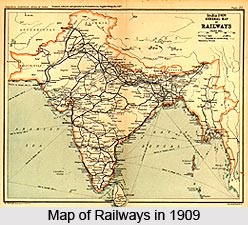 Development in Transport was mainly witnessed in roads and railways. The Mughals built roads and bridges near to their seat of power. Some new forms of wheeled transport had emerged since the seventeenth century. It never reduced the dependence upon bullock-carts, donkeys and camels. Considering military requirements between 1780 and 1840, the British began to repair, improve the roads of India. One of their major priorities was securing and improving communications between Calcutta and northern India.
Development in Transport was mainly witnessed in roads and railways. The Mughals built roads and bridges near to their seat of power. Some new forms of wheeled transport had emerged since the seventeenth century. It never reduced the dependence upon bullock-carts, donkeys and camels. Considering military requirements between 1780 and 1840, the British began to repair, improve the roads of India. One of their major priorities was securing and improving communications between Calcutta and northern India.
A military road staring from Calcutta to Benares was constructed in 1781. This was again followed in 1833 by reconstruction of the Grand Trunk Road. This road by the year1855 had reached Karnal. Between 1820 and 1850 military roads were built. One was built under Lord Wellesley which served as a military supply route. It was later converted to a metalled road. In the southeast, roads were built in order to merge the British hold on south India. The construction of Grand Trunk Road sparked a limited revolution in transport between Calcutta and the northwest. Horse-carriages replaced slower modes of transport by early 1850s. Throughout the nineteenth century roads continued to be built in areas such as the Central Provinces, where railways could not penetrate. In fact these roads played a major role in promoting economic integration and merging political authority. Steam locomotion did not prevent the need for older dispersed transport technologies.
India`s inland coalfields could not be exploited until the introduction of railways. Coal transportation was one of the main incentives behind the early drive for railway construction in India. One of the first railway lines to be completed, in 1855, ran around 120 miles from Hooghly to the Raniganj coalfield. However due to high demand for cotton from Deccan and North India also led to more construction of railway routes. British trade and industry now had greater access to Indian markets as well as to the sources of cotton, oil-seeds, grain and other major goods. Railways were considered as an effective means of fighting famine thereby facilitating the desired growth of the market economy. The Locomotives and the railway network helped the British to furnish certain proof of their material superiority and their commitment to civilizing and improving the Indian society. Railways have had a great socio-economic impact on Indian society.



















